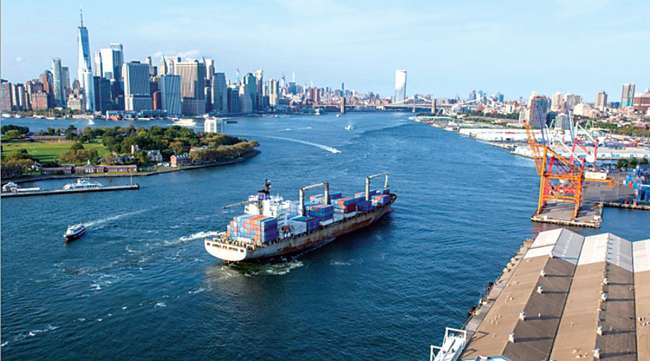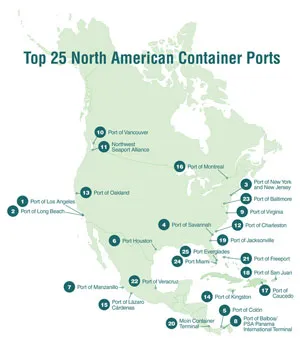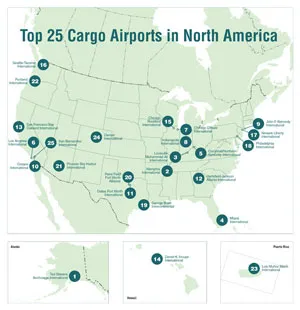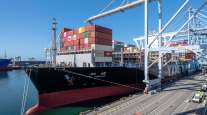Features Coordinator
Ocean, Airfreight Volumes Falter in Rocky 2023

[Stay on top of transportation news: Get TTNews in your inbox.]
Ports
The downward trend in ocean freight volumes that began in 2022 continued last year, with many major ports reporting declines in throughput of containerized cargo.
Transport Topics’ updated Top 25 list of the largest container ports in North America features a shakeup in the top three, with the Port of Long Beach reclaiming the No. 2 spot.
The Port of New York and New Jersey, which had climbed to the second-highest ranking on last year’s list, dropped to No. 3 after a 17.7% decline in throughput in 2023.
Most other container ports also experienced reduced volumes in 2023. Across the top 25, throughput decreased an average of 9.5% from the prior year.

Only six ports on this year’s list processed more containers in 2023 than in 2022. Of those six, only two — Jacksonville and Baltimore — are in the United States.
This reduction in container traffic largely represents a return to pre-pandemic levels as seaports that handled record volumes during the COVID-19 pandemic experience a regression toward the mean.
Container volumes also were negatively affected by extreme weather and geopolitical events, including a prolonged drought at the Panama Canal that began early in the year and conflicts in the Middle East and Red Sea.
Of the 25 ports listed, the largest year-over-year percentage increase in 20-foot-equivalent units came at the Port of Manzanillo in Colima, Mexico. Manzanillo has seen massive growth driven largely by the nearshoring of manufacturing by U.S. companies, a trend that has gained momentum in recent years. Mexican ports have also benefited from a rise in imports from China.
While 2023 was largely a down year for North America’s busiest seaports, the final quarter brought positive signs as container traffic surged in several locations. According to a report by commercial real estate firm CBRE, cargo container volume at the 14 North American ports tracked by the company increased 1.6% year over year.
This strong fourth-quarter volume was fueled by a resilient U.S. economy, which grew at a faster-than-expected rate of 3.2%, and strong import demand.
Airports
Although airfreight demand has been rising this year, cargo volumes at North American airports remained soft in 2023 as the market normalized coming out of the pandemic-driven boom at the beginning of the decade.
Of the top 10 airports on Transport Topics’ updated Top 100 list of the busiest cargo airports in North America, five experienced year-over-year growth in landed tonnage last year while five saw declines.
Looking further down the list, the results shift from middling to skewing more negative, as 13 of the top 20 and more than 30 of the top 50 airports handled less cargo in 2023 than in 2022.
According to the International Air Transport Association, the North American air cargo market experienced a 4.3% decline in international air cargo demand. Expanded to include domestic demand, the decline widens to 5.7%.
The downturn in North America was steeper than the global declines of 2.2% for international airfreight and 1.9% for international and domestic. Europe, the region with the next-largest declines, saw international and total demand reductions of 4.1% and 3.9%, respectively.
Parallel to ocean freight, airfreight volumes seemed to rebound in the closing months of 2023 with slight year-over-year increases in tonnage.
The top three cargo airports in North America remained unchanged on this year’s list, with Ted Stevens Anchorage International in Alaska maintaining the top spot as a major hub for both FedEx and UPS and a key point on the supply chain for North American goods being transported around the globe. Landed cargo at Anchorage increased by 5.6% in 2023, further cementing it as North America’s busiest cargo airport.

Memphis International, the home of FedEx World Hub, and Louisville Muhammad Ali International, which houses UPS Worldport, again round out the top three. Both airports experienced declines in cargo handled, with volume falling 1.9% and 6.1%, respectively.
Los Angeles International, No. 6 on this year’s list, dropped two spots from its 2022 ranking due to a 24.8% decline in landed tonnage. It was supplanted by Miami International and Cincinnati/Northern Kentucky International, which handled 7.5% and 16.1% more cargo year over year, respectively.
Want more news? Listen to today's daily briefing below or go here for more info:





